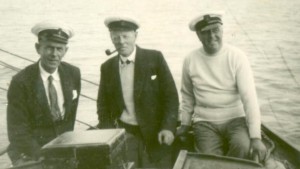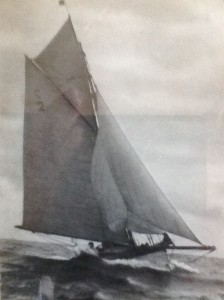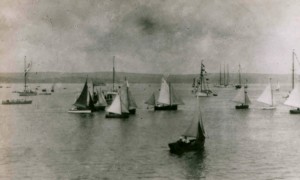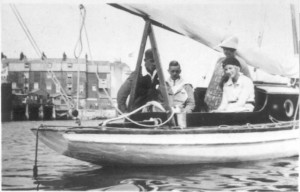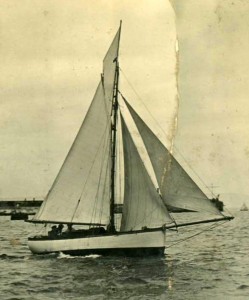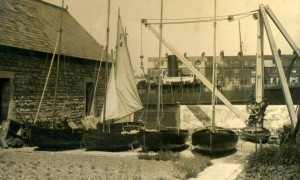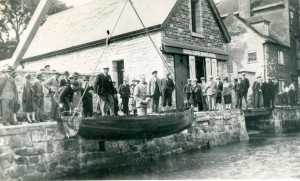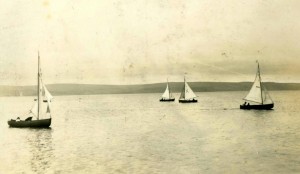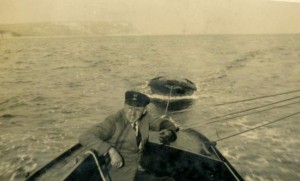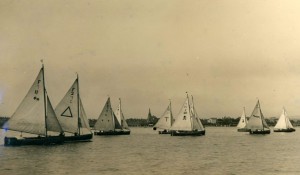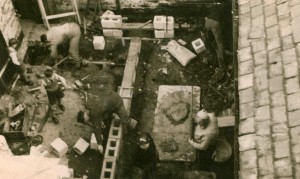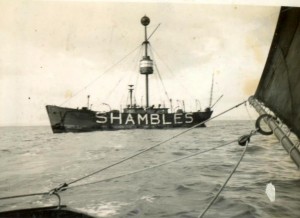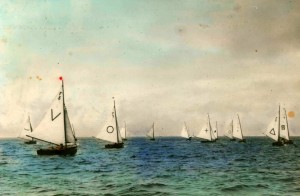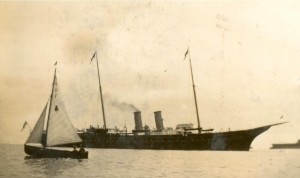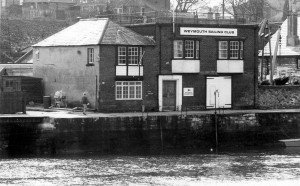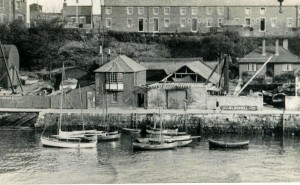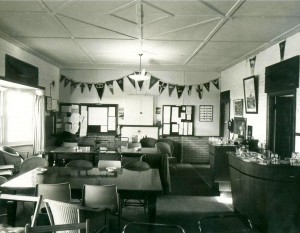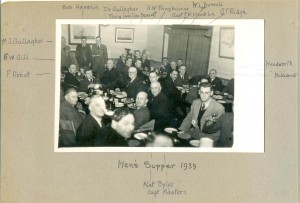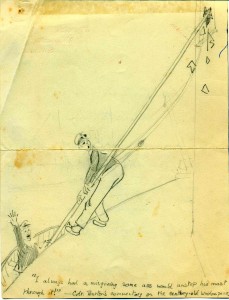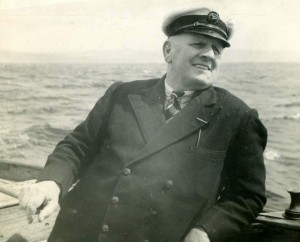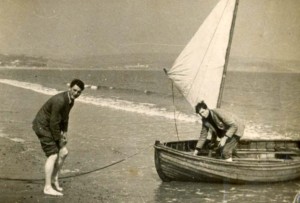Committee Work
The work of the committee during the early months of 1921 was summarised by Mr. Hownam Meek, the new Commodore-elect, at the A.G.M. as follows:-
[1] Re-classification of club boats. Class A: Larger and faster boats. Class B: Light class of fast boats. Class C: Slower and smaller boats.
[2] Club Course. To remain as at present, but the O.D. to decide in which direction it be taken in order to give a beat to windward on one leg.
[3] Handicapping. [Racing rule 4] to be altered to reduce adjustment units from 30 secs. to 15.
[4] Challenge Cups. Hambro Cup:- Class A ; Huxtable Rose Bowl:- Class B; Rink Cup:- Class C; Franklin Smith Cup:- Special all-in-race.
[5] Miniature Cups to be presented to holders of challenge cups on their return at the end of the season. [By arrangement with Mr. J. Taylor of Vincent’s].
[6] Lifebuoys. Whilst the Y.R.A. rule requiring these to be carried would not be made compulsory, it was very necessary that some form of life-saving apparatus should be carried in each boat.
On the subject of the new B class the Commodore referred to the lighter and speedier class of boats being introduced into the club, and expressed his appreciation of the sporting spirit of those who had provided them. Captain Cooke [the harbour master] promised to do his best to arrange for moorings for club boats whilst dredging operations were being carried on; and the thanks of the meeting were accorded to the Commodore and Mr. Bond for their generous offer of spoons to winners of races in the contests for challenge cups.
In the election of officers, Mr. Pitcher was promoted to Vice-Commodore and Mr. Bond took his place as Treasurer, whilst Mr. Donnelly was appointed official time-keeper and Mr. Hillier was elected to a seat on the committee. The accounts showed a balance of £20 which was considered highly satisfactory.
The ‘lighter and speedier boats’ included four newcomers in the revised B class, viz. Mr. Homes’ lugger ‘Ripple’, Mr. Stancombe’s ‘Scrap’, Mr. Bussell’s newly-built dinghy ‘Sonia’, named after his grand-daughter, and Mr. Bond’s ‘Wendy’ [replacing ‘Bunty II’]. The remaining boats in this class were our old friends ‘Kelpie’ and ‘Albatross’. Mr. Byles also acquired a new lugger ‘Puffin’, in place of ‘Redwing’, in class A; while C class included three notable new arrivals – ‘Saucy Polly’ [Taylor and Hedges] ‘Tom Tit’ [C. E. Phillips] and ‘Young Feller’, skippered by the club’s second lady member, Mrs. Hownam Meek. These additions brought the fleet up to a total of 28, of which ‘Saucy Polly’ still survives and is going strong at Castle Cove.
The programme of seven trophy races was supplemented by a Town Regatta [at last!], the R.D.Y.C. regatta [club race] and an extra series of three races for trophies presented by Mrs. Hownam Meek and Mr. Pitcher [two special classes]. The formality of the ‘opening cruise’ was quietly allowed to lapse.
Committee meetings were now usually held at the Cove Inn and in the minutes of one of these we read that ‘Mr. Byles expressed the opinion that it would be a great convenience if the club had a headquarters of its own, and proposed that the Secretary write to the O.C., R.A.S.C. to see if their shed on the quay might be leased to the club.’ Nothing came of this particular enquiry, but it started people thinking along the right lines.
A Fine Summer
The summer of 1921, as some will remember, was brilliantly fine, and all the racing events were keenly contested. The Hambro Cup [A class] was won by Mr. Twitchett’s ‘Hirondelle’ and the Rink Cup [C class] was happily carried off by Mr. Wakefield in ‘Reliance’. Competition for the Rose Bowl in the newly-constituted B class was so keen that it resulted in a tie between Mr. Bond’s ‘Wendy’ and Mr. Stancombe’s ‘Scrap’. The deciding duel between these two was sailed off in a strong wind [force 4-5], in which ‘Wendy’ scored a thrilling victory by 12 seconds nett time.
The R.D.Y.C. regatta was also sailed in a high wind, so strong that ‘Margot’ lost her mast, and ‘Jose II’ and ‘Hirondelle’ also gave up with damaged rigging. Winners in the two classes were ‘Ripple’ and ‘Fifi’.
The Town regatta on the other hand, was sailed in a very light breeze. Its programme included a race for professional boatmen, among whom we observe our old friend Mr. Percy Rule [‘Shamrock’] and two classes [A and B] for amateurs in Weymouth and Portland.
The Dorset Daily Press put up a cup for the A class and this was won by Mr. Bond’s champion, ‘Wendy’; with ‘Scrap’ second and ‘Dolphin’ third. The B class winner was none other than ‘Young Feller’ thus putting a large feather in the cap of Mrs. Hownam Meek, who in her own words ‘would not have changed places with anyone else in the world.’
Mrs. Hownam Meek’s promised trophy for the supplementary race was a silver cigarette box, and this was won by the peerless ‘Wendy’ [two firsts] while the corresponding Pitcher Cup [B class] went to ‘Saucy Polly’.
The Franklin Smith Cup took place in a hard sou’wester and was won by Mr. Pitcher’s ‘Dolphin’. The report mentions that ‘one of the yachts capsized in proceeding to its moorings, the two occupants being thrown into the water, from which they were rescued without much difficulty’ – the withholding of the identity of the victims speaks well for Mr. Wakefield’s discretion.
A last final race ‘specially designed to give non-prizewinners some slight souvenir of their season’s racing’ was sailed on Sept. 21st and was won by Mr. Bussell’s ‘Sonia’ [class A] and Mr. Phillips ‘Tom Tit’ [B] four boats entering for each race.
Annual Dinner
The brilliant season was wound up with a prize giving [stag] dinner at the Crown Hotel on Oct. 15th, attended by 30 members and a number of honoured guests, including the Town Clerk, the Hon. timekeeper [Mr. Donnelly] and the editor of the Dorset Daily Press, a certain Capt. A. E. Brown. The D.D.P. report tells that a ‘feature of the table was the menu cards showing photos of various club boats with their racing flags, principally the work of Mr. Hownam Meek and Mr. Bond. During the business of the evening Mr. Donnelly and Mr. Wakefield were enthusiastically elected ex-officio honorary members of the club. The prizes, which included ten spoons for first places, were presented by Mrs. Hownam Meek, to whom Mr. Bond proposed a vote of thanks in which he expressed the hope that ‘in the lovely bay Weymouth possesses there might be a Ladies’ Race in the future.’ At this point we read that Mr. Home, who rose to second, ‘was scarcely heard owing to the enthusiastic reception of the proposal.’
Capt. Brown, in proposing the health of the club, said that the Cup put up by the Dorset Daily Press for the Town Regatta would gladly be replaced if won outright and commented favourably on the idea of a Ladies Cup. The Commodore, replying, ‘expressed his delight at the successful season just concluded. No race had to be postponed on account of the weather, there had been no friction in the club, no protests, and he had had the pleasure of welcoming a number of newcomers and new boats.’
The Hon. Secretary reported that there were 23 boats sailing regularly in the club races, and 40 subscribing members; and Capt. Brown, rising again in response to a vote of thanks from Mr. Bond for the D.P.D cup, ‘promised that in the event of a Ladies’ Race being sailed, the firm [or he personally] would present a cup for the occasion,’ thus foreshadowing the Dorset Daily Echo Cup, now such a feature of our traditional Ladies’ races. ‘The evening concluded,’ we read ‘by drinking the health of the Commodore and Mrs. Hownam Meek with musical honours’. [ – ‘Jolly Young Fellers’?].
Mr. Bond Departs
At times of elation, Fate often provides a sobering corrective, and this occurred at the end of 1921 in the unexpected transfer of Mr. Bond to Falmouth, necessitating his resignation as Treasurer [and leading sportsman] of the club. Mr. Meek is reported as saying at the time that ‘in losing Mr. Bond the club would sustain a serious loss; he had provided a first class boat [‘Wendy’] and had always raced her in a sporting manner.’ Thus Mr. Bond – and ‘Wendy’ – pass from the annals of the club leaving behind them a glowing reputation and a large gap.
Fewer Boats
In the course of the ensuing winter the club lost several other members besides Mr. Bond, with a resulting depletion in boats for the 1922 season, particularly in the successful new B class. ‘Wendy’ had gone to Falmouth, and now her sparring-partner ‘Scrap’ dropped out through the departure of Mr. Stancombe while Mrs. MacKenzie-Grieve gave up ‘Kelpie’ and Mr. Bussell sold ‘Sonia’ for a new A class boat [‘Yvette’]. The three last named defaulters ultimately returned to the fold under new ownership, but at present only ‘Ripple’ and ‘Albatross’ remained out of the original six, so the committee proposed that B class be suspended.
This set-back was partly compensated for by the addition to A class of two large cabin cruisers, Mr. Hownam Meek’s ‘Idler’ and Mr. Pitcher’s ‘Windflower’, both of which were destined to be familiar sights in local waters for many years to come. ‘Windflower’, converted from gaff to Bermudan rig and now over 60 years old, has remained in the club ever since, earning the affectionate nickname of ‘Cauliflower’ with a suit of green sails.
Mr. Pitcher’s ‘Dolphin’ was bought by a club member, Mr. Oliver Walford; but Mr. Meek’s ‘Saracen’ was sold ‘down the river,’ as also were ‘Hirondelle’ and ‘Black Arrow’, whose owners departed. Moreover the R.A. Mess at Red Barracks was dissolved, so ‘Sprig’ ceased to function; the Inniskilling Fusiliers had departed, taking ‘St. Barbara’ away; and ‘Margot’s’ owner, Major Foster, was posted abroad. Thus the A class ‘felt the draught’ as well, and the season began with only 17 boats – 10 in A class and 7 in C.
Officers Re-elected
At the Annual General Meeting all the existing officers and committee men were re-elected, Mr. Bond’s place as Treasurer being taken by Mr. Home. Mr. Pitcher [temporary acting Hon. Treasurer] explained that a drop of £5 in the year’s trading represented a donation to the Town regatta, and the balance in hand of £14 was considered satisfactory. A letter from the Weymouth Hospital inviting the club to take part in a Carnival was read ‘and ordered to lie on the table, as it could not be clearly seen how the club as a body could take part.’ – A gaff-rigged lorry perhaps?
The proposal to suspend B class having been confirmed, it was agreed that the Rink Cup, thus rendered spare, should be used for a special race to be defined later. Mr. Hownam Meek, in returning thanks for his re-election as Commodore said that ‘the innovation of a beat to windward in every race had produced a much more reliable average of results. Some boats had gone away from the club, but he hoped to get ‘Sonia’ back, as her type was essentially suitable and might be regarded as a future standard. He further suggested that, ‘in view of the number of members living around the old Castle, there might be one race held in Portland Harbour this year.’ This suggestion was unanimously approved.
Two Innovations
At the A.G.M. the Hon. Secretary was instructed to ask the editor of the Dorset Daily Press his intentions in regard to the suggested Ladies’ Cup, and to this Capt. Brown came back with the promise of a cup, value £2. 2s., to be sailed for by ladies and to be won outright. In accepting this offer the committee ruled that all boats taking part must belong to members of the club, and that ‘none but ladies might handle the tiller,’
The 1922 fixture list of eleven trophy races included a race in Portland Harbour on July 8th and a Ladies race on Aug. 9th, two innovations constituting milestones in the club’s history, and therefore worthy of special attention in this chronicle.
The First Portland Harbour Race
‘The race arranged to be sailed in Portland Harbour on July 8th’ records Mr. Wakefield ‘was found to be impossible owing to one of the heaviest gales of recent years, the force of wind for the district being officially returned as 57m.p.h. There being no race, the Commodore and Mrs. Hownam Meek very kindly entertained the members to tea at the Rambler Tea Rooms [Old Castle Road].’ The postponed race was sailed on Saturday Aug. 19th ‘starting from Castle Cove with the 2,OOOyd. Torpedo Raft as first mark and North Entrance Buoy as the second.’ The class A race was won by Mr. Bussell in ‘Yvette’, with eight competitors, and in C class ‘Young Feller’ [Mrs. H. Meek] beat her only rival, ‘Saucy Polly’, on handicap allowances.
The First Ladies’ Race
In the meantime the eagerly-awaited Ladies’ race was sailed on Aug. 9th by nine entrants in rather severe weather conditions: ‘wind force 3-4 varying W. to N. with squalls and showers.’ With the exception of Mrs. Hownam Meek these competitors were not members of the club, any friends or relations of members being apparently permitted to enter. Their names were: Miss J. Carter [of the D.D.P.], Miss Hillier, Mrs. Adams, Miss Broomfield, Mrs. Barnes, Miss Hedges, Miss Janet Byles and Mrs. Campbell. Mrs. Hownam Meek won the race in ‘Young Feller’ on corrected time, the others being placed in the above listed order.
The Dorset Daily Press not only gave this race a glowing ‘write up’ but actually entered its representative as one of the competitors, in Mr. Wakefield’s ‘Reliance’. The report [of which a cutting is preserved] says: ‘Considering that some of the ladies had not had any practice, they did very well indeed and sailed a very good race. A D.D.P. reporter who is quite a novice can bear testimony to the strain put on the helmswomen and the splendid manner in which they bore it. The Cup was well won, and congratulations are due to Mrs. Hownam Meek on becoming the first holder. Mrs. Meek is the only lady who sails regularly in club races and … has always shown a sporting spirit.’
The Regattas
The R.D.Y.C. Regatta was a poor affair this year, the only event being that provided by the W.S.C. [9 boats] ‘Jose II’ won the A class race and ‘Saucy Polly’ the other [B] in such light airs that it took three hours for the leading boats to complete one circuit of the course. Two sets of handicaps had been prepared for this race – ‘wind below force 3’ and ‘force 3 or over.’
By contrast, the Town Regatta was held in brilliant weather [Aug 23rd] and is reported as ‘one of the jolliest holiday festivals in the town’s history.’ In the race for professional boatmen, sponsored by the Sailing Club [£5-5s. in prizes], we note the familiar names of the three Browns [Harold, Albert and Frank], F. Glover and Percy Rule [who was disqualified.]
The amateur race for the D.D.P. Cup was won by Mr. Bussell in ‘Yvette’, with Mr. J. Vine’s ‘Grace’ second. The other club winners were ‘Saucy Polly’ and ‘Lena’.
Races, Rescues and Ties
The season’s trophy races resulted in the Hambro Cup [A class] going to Mr. Byles [‘Puffin’] and the Rose Bowl [C class] to Messrs. Taylor and Hedges [‘Saucy Polly’]. The two spare trophies – Franklin Smith and Rink Cups – were competed for in a series of three consolation races [A and C classes], and a further series of three special races were scheduled for cash prizes put up by Mrs. Meek and Mr. Pitcher [the Vice-Commodore] .
These latter races got badly disorganised by the weather, which broke early this year, causing frequent postponements and abandonments. The most eventful of them was the second Cup race, which was sailed [after two cancellations] in a howling gale [force 6-8] on Sept. 16th, and ended [as Mr. Wakefield mildly put it] ‘in a very indeterminate manner.’ His report records that ‘Fifi’ capsized in rounding the first mark and her occupants were picked up by Mr. Hillier in ‘Albatross’ while ‘Yvette’ [Mr. Bussell] left the A class race to take the wreck in tow. Meanwhile four beach boats, being rapidly blown out to sea, attracted the attention of Mr. Hownam Meek in ‘Idler’, who also dropped out on rescue work; leaving ‘Windflower’ and ‘Jose II’ to battle on round the course, which they completed to score a tie, their nett times working out identical to a second!
In a deciding duel on Sept. 30th the Franklin Smith Cup was finally won by Mr. Pitcher [‘Windflower’], while the Rink Cup was awarded to Mr. Hillier [‘Albatross’] ex gratia, with a letter expressing appreciation of his ‘promptness and ability in picking up the crew of ‘Fifi’ under difficult circumstances.’ The old rivals ‘Windflower’ and ‘Jose II’ also tied for the only two races sailed in the cash prize series, but as the weather was now hopelessly stormy no attempt was made at another sail-off, Mr. Pitcher and Mr. Miles agreeing to divide Mrs. Hownam Meek’s cheque between them. Mr. Pitcher’s cheque was won by Mr. Hillier.
A new method of handicapping by a percentage ‘time on time’ system attributed to the Singapore Yacht Club, is described in the minute book and was suggested for use in the special series races, but ‘was not employed, the existing method proving quite effective’ – witness ‘Windflower” and ‘Jose II’! The method has since been adopted in principle for all handicap allowances.
Annual Dinner
The prizegiving dinner again took place at the Crown Hotel, and this time the table decorations were ’embellished with model yachts made by the two Commodores and Messrs. Bussell and Byles.’ Mrs. Hownam Meek again came in to distribute the prizes, and Mr. Donnelly, the timekeeper, was presented with a souvenir napkin ring. Mr. Haines, in proposing the toast of ‘The Club’, said that it ‘set up a standard that many others would do well to emulate. He had crewed in one particular boat all the season and was struck by the skill and sportsmanship shown by all concerned.’
The Commodore, in summarising, said ‘the strength of the club lay in the team spirit of individual members,’ and the Hon. Secretary concluded with a tribute to the Commodore’s ‘genial personality which made him welcome wherever he went.’
Projected Sports Club
As a final note on the year 1922, the minute book contains a cutting from The Southern Times of Oct. 28th eulogising the club and favouring a current scheme for the formation of a united sporting club. It runs:
‘The success of the Weymouth Sailing Club is highly gratifying, especially when contrasted with the dolorous plight of other aquatic organisations. The sailing competitions held regularly during the summer are a most picturesque feature of the season …. The club is fortunate in having at its head men to whom sailing is a passion, and who know nearly all there is to know about it .. . At the convivial gathering which terminated the season, advantage was taken of the opportunity to discuss the proposal to establish an Amalgamated Sports Club, and the provision of a club-house which would be the central rendezvous for sailing and rowing men, swimmers and sportsmen generally. It is an admirable proposal, and we hope it will materialize.’
As a rejoinder to these sentiments one is tempted to remark that ‘others have contrary opinions!’
